-
Paper Information
- Previous Paper
- Paper Submission
-
Journal Information
- About This Journal
- Editorial Board
- Current Issue
- Archive
- Author Guidelines
- Contact Us
International Journal of Textile Science
p-ISSN: 2325-0119 e-ISSN: 2325-0100
2017; 6(4): 105-109
doi:10.5923/j.textile.20170604.02

Study on the Production Techniques for Various Colorful Mono Fancy Yarns in Ring Spinning Frame and Glow Yarn
Md. Khalilur Rahman Khan
Department of Textile Engineering, Bangladesh University of Business and Technology, Mirpur, Dhaka, Bangladesh
Correspondence to: Md. Khalilur Rahman Khan, Department of Textile Engineering, Bangladesh University of Business and Technology, Mirpur, Dhaka, Bangladesh.
| Email: |  |
Copyright © 2017 Scientific & Academic Publishing. All Rights Reserved.
This work is licensed under the Creative Commons Attribution International License (CC BY).
http://creativecommons.org/licenses/by/4.0/

Designers are concentrating on using of colored fancy yarns in all types of apparel having decorative effect, either knitted or woven, with creative ideas that can attract consumers of dynamically stimulated markets by adding minimum costs. In this study, the production techniques of some colorful mono fancy yarns are briefly described. Although colorful fancy yarn can be produced by plying operation after spinning stage by using two or more single yarns but here we would like to highlight only colorful mono fancy yarns those are produced by using ring spinning frame. Here, Glow yarn that is mainly produced by direct spinning system is also discussed briefly.
Keywords: Fancy Yarn, Gradient yarn, Mottle Yarn, Injected Slub Yarn, Mosaic Yarn, Vario-Siro Yarn, Glow Yarn
Cite this paper: Md. Khalilur Rahman Khan, Study on the Production Techniques for Various Colorful Mono Fancy Yarns in Ring Spinning Frame and Glow Yarn, International Journal of Textile Science, Vol. 6 No. 4, 2017, pp. 105-109. doi: 10.5923/j.textile.20170604.02.
Article Outline
1. Introduction
- Fancy yarns, also called novelty or effect yarns, and represents a category of yarns in which deliberate irregularities, discontinuities and color variations are introduced into the yarn structure with the primary intention being to produce enhanced aesthetic and fashionable impressions [1]. Nowadays, interest in fancy yarns creation, production, and applications is increasing to improve the appearance of the garment. Such yarns, because of their decorative effect in knitted and woven fabrics, have considerable commercial significance. Unending search for novelty applies to both men’s and women’s wear to give greater sales appeal. It also carries significant demand for children outerwear. Furnishing is also an important market area particularly curtains, blinds and wall coverings and upholstery [2]. In general, fancy yarn may be divided into two major categories: mono-fancy yarns and compound fancy yarns. The former are made from a single step fiber strand or multi-filament yarn in which irregularities are introduced during the conversion from fiber to yarn; the latter consists of two or more fiber strands used to provide the desired combined effects [1]. Fancy yarns having impression of lively color has leading impact in terms of fashion and appearance to the textile products. The impact of colorful fancy yarn in the fabric can also be heightened by careful planning of the contrast between fancy and plain yarns. Colorful fancy yarn finds applications in normal and high-fashion clothing. In most cases fancy yarns have a multithread structure composed of such components –core, effects and binder [3]. These types of fancy yarns are produced after spinning stages. In this paper, we will review only colorful fancy yarns produced during spinning stages. Ring spinning technology is widely used as the benchmark for staple yarn quality. Although production rate of ring spinning system is very much lower in comparison with that of the modern spinning system, but the opportunity of ring spinning system to produce fancy yarns by doing simple modifications in its structure enable this spinning system still best competent in the arena of yarn production unquestionably. In general, Literature reviews are in great demand in most scientific fields. The studies on already invented methods open the doors in the way of modifications by researchers. From this perspective, it is attempted to make a study on the methods of colorful mono fancy yarn production by ring spinning frame. In addition, applications of such colorful mono fancy yarn will be mentioned also. In this study, It is also tried to discuss the glow yarn in brief.
2. Production Techniques for Colorful Fancy Yarn
- A. Gradient yarn:Gradient yarn is one where the colors change evenly from one color to the next [4]. The arrangement of roller drafting system for blending slivers of two colours on the draw frame in a controlled manner is shown in Fig. 1. The drafting system consists of two main sections: pre-drafting section and the main drafting section. The slivers of different colours are first pre-drafted separately, in the respective pre-drafting zones, and then fed together into the main-drafting section. Between the two drafting sections is a zone where no draft is applied on the slivers. This zone has been named as convergence zone. Changing its pre-draft can control the ratio of any colour in the output sliver. It is very important that the linear density of the output sliver remains constant with time. As long as drafts in the two pre-drafting zones are changed such that the mean pre-draft remains constant an output sliver with varying colour composition and constant linear density is obtained [5].
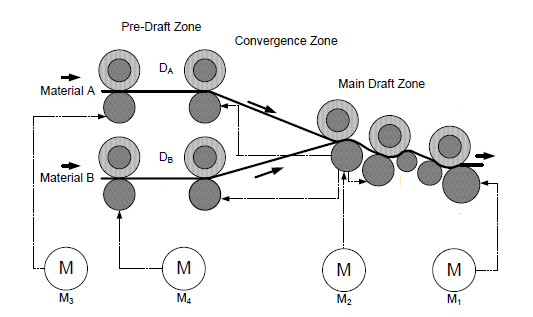 | Figure 1. Drafting arrangement for gradient yarn production |
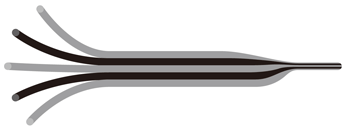 | Figure 2. Sliver blending |
 | Figure 3. Fabrics produced from gradient yarn |
 | Figure 4. Mottle Yarn production |
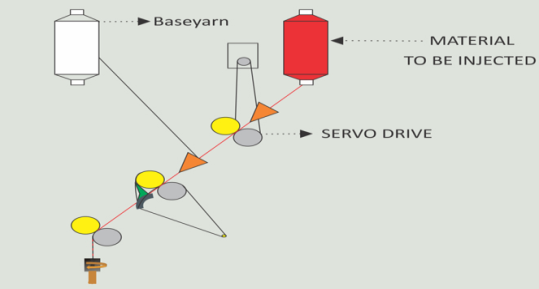 | Figure 5. Production of color injected slub yarn |
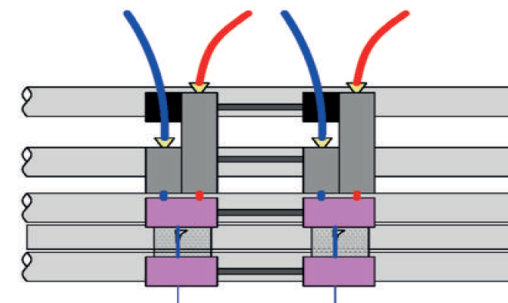 | Figure 6. Mosaic yarn production |
 | Figure 7. (a) Plain mosaic yarn, (b) Slub in mosaic yarn & (c) Adding slubs to create mosaic effect |
 | Figure 8. Colorful vario-siro yarn |
3. Glow Yarn
- Latest inventions and technologies play an integral part in the textile industry. The glow yarn is another example for the innovativeness of textile researchers [11]. Currently high-visibility clothing is worn to alert others in low light and dark conditions. Cyclists, railway and highway workers, airport workers, emergency services are common users of high-visibility clothing. However, these types of textiles are made from glow yarn. Glow yarns can be used creatively in many applications for embroidery, sewing thread, shoes, ropes, tents, beads etc. Glow yarn can be produced by direct spinning system. Glow yarn is generally two types: (i) Electroluminescent (EL) glow yarn and (ii) Photo luminescent (PL) glow yarn.
3.1. Photo Luminescent (PL) Glow Yarn
- Photoluminescence is the one form of the luminescence in which the excitation energy source is incident light [12]. Photo luminescent (PL) glow yarn (shown in fig-9(a), (b)) is a new revolutionary luminous filament yarn developed by mixing, melting and extruding polyester chips with photo luminescent pigments. This is with strong light absorbing-storing-emitting luminescent materials. It automatically glows in the dark after absorbing sunlight for 3 minutes or luminous light for 20 minutes. One hour of sunlight exposure would enable the glow yarn to emit light for upto 3 hours continuously. This light absorbing process of absorbing-emit-storing-emitting can be repeated indefinitely [13].
3.2. Electroluminescent (EL) Glow Yarn
- Researchers at The University of Manchester have developed high-tech battery-powered textile yarns that can be used to make clothing glow in the dark [14]. The yarn consists of an inner conductive core yarn, coated with electroluminescent ink -- which means it emits light when an electric current is passed through it -- and a protective transparent encapsulation, with an outer conductive yarn wrapped around it that is shown in fig-9(c) [15].
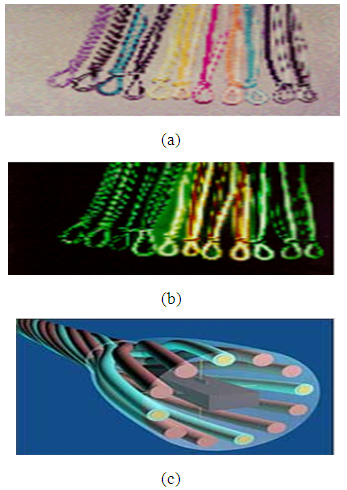 | Figure 9. Photo luminescent glow yarn (a) in normal light, (b) in dark & (c) Cross-sectional view of EL glow yarn |
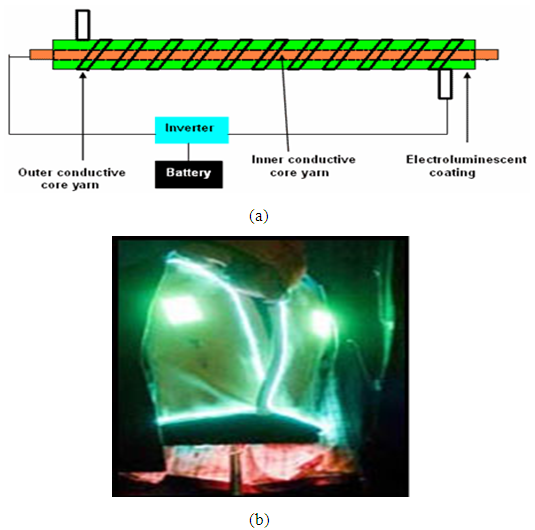 | Figure 10. (a) Electroluminescent (EL) glow yarn & (b) Fabric made from EL glow yarn in dark |
4. Conclusions
- The basic purpose of producing colored fancy yarn is to add color that is mainly attributed to the value addition obtained in terms of visual effects of fashionable apparel. On the other hand, the application of glow yarn in apparels is increasing day by day for visibility purposes in dark area. Now a days many companies offer a wide range of above mentioned products. It is expected that in future market value of colored fancy yarn will exploit huge profits. It is highly predictable and also expected that new methods for producing more colored fancy yarns will be discussed by researchers in near future.
 Abstract
Abstract Reference
Reference Full-Text PDF
Full-Text PDF Full-text HTML
Full-text HTML